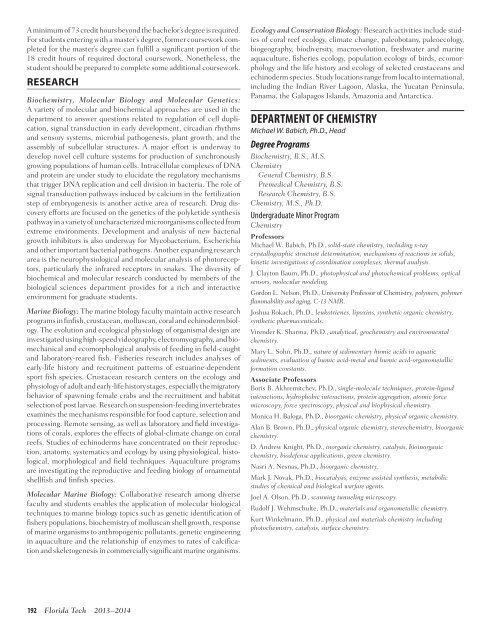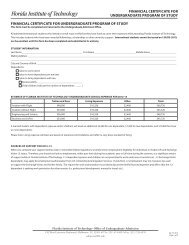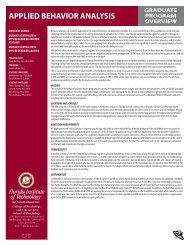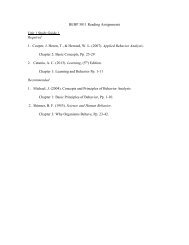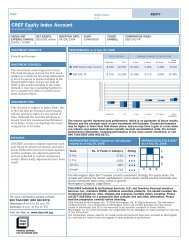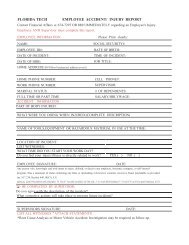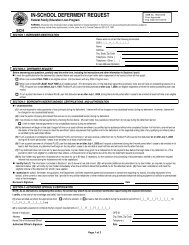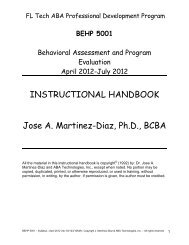2013–2014 UNIVERSITY CATALOG - Florida Institute of Technology
2013–2014 UNIVERSITY CATALOG - Florida Institute of Technology
2013–2014 UNIVERSITY CATALOG - Florida Institute of Technology
You also want an ePaper? Increase the reach of your titles
YUMPU automatically turns print PDFs into web optimized ePapers that Google loves.
A minimum <strong>of</strong> 73 credit hours beyond the bachelor’s degree is required.<br />
For students entering with a master’s degree, former coursework completed<br />
for the master’s degree can fulfill a significant portion <strong>of</strong> the<br />
18 credit hours <strong>of</strong> required doctoral coursework. Nonetheless, the<br />
student should be prepared to complete some additional coursework.<br />
RESEARCH<br />
Biochemistry, Molecular Biology and Molecular Genetics:<br />
A variety <strong>of</strong> molecular and biochemical approaches are used in the<br />
department to answer questions related to regulation <strong>of</strong> cell duplication,<br />
signal transduction in early development, circadian rhythms<br />
and sensory systems, microbial pathogenesis, plant growth, and the<br />
assembly <strong>of</strong> subcellular structures. A major effort is underway to<br />
develop novel cell culture systems for production <strong>of</strong> synchronously<br />
growing populations <strong>of</strong> human cells. Intracellular complexes <strong>of</strong> DNA<br />
and protein are under study to elucidate the regulatory mechanisms<br />
that trigger DNA replication and cell division in bacteria. The role <strong>of</strong><br />
signal transduction pathways induced by calcium in the fertilization<br />
step <strong>of</strong> embryogenesis is another active area <strong>of</strong> research. Drug discovery<br />
efforts are focused on the genetics <strong>of</strong> the polyketide synthesis<br />
pathway in a variety <strong>of</strong> uncharacterized microorganisms collected from<br />
extreme environments. Development and analysis <strong>of</strong> new bacterial<br />
growth inhibitors is also underway for Mycobacterium, Escherichia<br />
and other important bacterial pathogens. Another expanding research<br />
area is the neurophysiological and molecular analysis <strong>of</strong> photoreceptors,<br />
particularly the infrared receptors in snakes. The diversity <strong>of</strong><br />
biochemical and molecular research conducted by members <strong>of</strong> the<br />
biological sciences department provides for a rich and interactive<br />
environment for graduate students.<br />
Marine Biology: The marine biology faculty maintain active research<br />
programs in finfish, crustacean, molluscan, coral and echinoderm biology.<br />
The evolution and ecological physiology <strong>of</strong> organismal design are<br />
investigated using high-speed videography, electromyography, and biomechanical<br />
and ecomorphological analysis <strong>of</strong> feeding in field-caught<br />
and laboratory-reared fish. Fisheries research includes analyses <strong>of</strong><br />
early-life history and recruitment patterns <strong>of</strong> estuarine-dependent<br />
sport fish species. Crustacean research centers on the ecology and<br />
physiology <strong>of</strong> adult and early-life history stages, especially the migratory<br />
behavior <strong>of</strong> spawning female crabs and the recruitment and habitat<br />
selection <strong>of</strong> post larvae. Research on suspension-feeding invertebrates<br />
examines the mechanisms responsible for food capture, selection and<br />
processing. Remote sensing, as well as laboratory and field investigations<br />
<strong>of</strong> corals, explores the effects <strong>of</strong> global-climate change on coral<br />
reefs. Studies <strong>of</strong> echinoderms have concentrated on their reproduction,<br />
anatomy, systematics and ecology by using physiological, histological,<br />
morphological and field techniques. Aquaculture programs<br />
are investigating the reproductive and feeding biology <strong>of</strong> ornamental<br />
shellfish and finfish species.<br />
Molecular Marine Biology: Collaborative research among diverse<br />
faculty and students enables the application <strong>of</strong> molecular biological<br />
techniques to marine biology topics such as genetic identification <strong>of</strong><br />
fishery populations, biochemistry <strong>of</strong> molluscan shell growth, response<br />
<strong>of</strong> marine organisms to anthropogenic pollutants, genetic engineering<br />
in aquaculture and the relationship <strong>of</strong> enzymes to rates <strong>of</strong> calcification<br />
and skeletogenesis in commercially significant marine organisms.<br />
192 <strong>Florida</strong> Tech <strong>2013–2014</strong><br />
Ecology and Conservation Biology: Research activities include studies<br />
<strong>of</strong> coral reef ecology, climate change, paleobotany, paleoecology,<br />
biogeography, biodiversity, macroevolution, freshwater and marine<br />
aquaculture, fisheries ecology, population ecology <strong>of</strong> birds, ecomorphology<br />
and the life history and ecology <strong>of</strong> selected crustaceans and<br />
echinoderm species. Study locations range from local to international,<br />
including the Indian River Lagoon, Alaska, the Yucatan Peninsula,<br />
Panama, the Galapagos Islands, Amazonia and Antarctica.<br />
DEPARTMENT OF CHEMISTRY<br />
Michael W. Babich, Ph.D., Head<br />
Degree Programs<br />
Biochemistry, B.S., M.S.<br />
Chemistry<br />
General Chemistry, B.S.<br />
Premedical Chemistry, B.S.<br />
Research Chemistry, B.S.<br />
Chemistry, M.S., Ph.D.<br />
Undergraduate Minor Program<br />
Chemistry<br />
Pr<strong>of</strong>essors<br />
Michael W. Babich, Ph.D., solid-state chemistry, including x-ray<br />
crystallographic structure determination, mechanisms <strong>of</strong> reactions in solids,<br />
kinetic investigations <strong>of</strong> coordination complexes, thermal analysis.<br />
J. Clayton Baum, Ph.D., photophysical and photochemical problems, optical<br />
sensors, molecular modeling.<br />
Gordon L. Nelson, Ph.D., University Pr<strong>of</strong>essor <strong>of</strong> Chemistry, polymers, polymer<br />
flammability and aging, C-13 NMR.<br />
Joshua Rokach, Ph.D., leukotrienes, lipoxins, synthetic organic chemistry,<br />
synthetic pharmaceuticals.<br />
Virender K. Sharma, Ph.D., analytical, geochemistry and environmental<br />
chemistry.<br />
Mary L. Sohn, Ph.D., nature <strong>of</strong> sedimentary humic acids in aquatic<br />
sediments, evaluation <strong>of</strong> humic acid-metal and humic acid-organometallic<br />
formation constants.<br />
Associate Pr<strong>of</strong>essors<br />
Boris B. Akhremitchev, Ph.D., single-molecule techniques, protein-ligand<br />
interactions, hydrophobic interactions, protein aggregation, atomic force<br />
microscopy, force spectroscopy, physical and biophysical chemistry.<br />
Monica H. Baloga, Ph.D., bioorganic chemistry, physical organic chemistry.<br />
Alan B. Brown, Ph.D., physical organic chemistry, stereochemistry, bioorganic<br />
chemistry.<br />
D. Andrew Knight, Ph.D., inorganic chemistry, catalysis, bioinorganic<br />
chemistry, biodefense applications, green chemistry.<br />
Nasri A. Nesnas, Ph.D., bioorganic chemistry.<br />
Mark J. Novak, Ph.D., biocatalysis, enzyme assisted synthesis, metabolic<br />
studies <strong>of</strong> chemical and biological warfare agents.<br />
Joel A. Olson, Ph.D., scanning tunneling microscopy.<br />
Rudolf J. Wehmschulte, Ph.D., materials and organometallic chemistry.<br />
Kurt Winkelmann, Ph.D., physical and materials chemistry including<br />
photochemistry, catalysis, surface chemistry.


